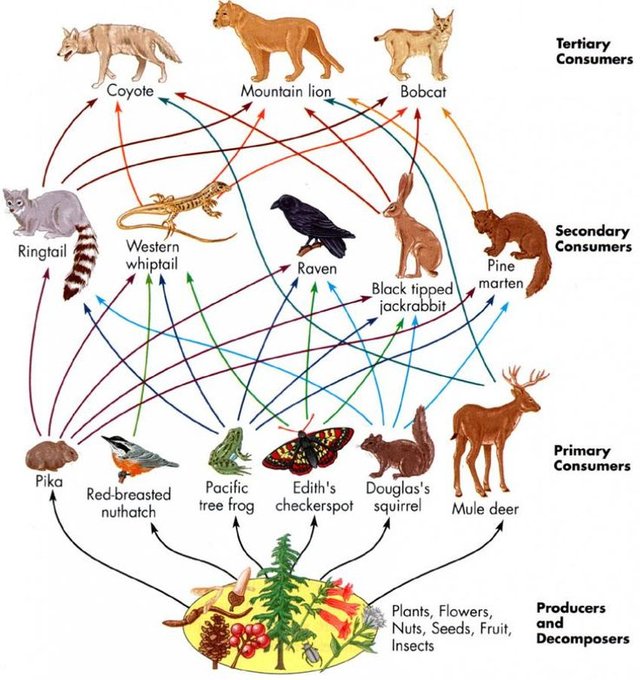Hey Steemit! I wanted to share a bit about the fascinating complexity of food webs and how they weave our world together.

Like I stated in my last Community Ecology post, we must first thank the autotrophs (aka PLANTS) for harnessing the sun's energy and allowing us to do work. With that energy, ecosystem communities evolve intricate interconnections working to create balance and stability (a dubious term in ecology, but an ideal nonetheless). We map this energy transfer through food webs (fig 1.1).

Figure 1.1: Food webs delineate the trophic interactions among all the species living in a community (Image from Socractic.org)
Within that community, keystone species have a disproportionately large influence on surrounding habitat relative to their species abundance (Power et al., 1996). While the ratio of keystone species to all other organisms may be low as, their actions have substantial impact on community structure and facilitate dramatic affects (both direct and indirect) on other species in an ecosystem (Molles, 2012, p. 382).
Robert Paine coined the term "keystone species" in the 60s when he hypothesized that predators promote higher biodiversity within an ecosystem because they keep various prey species below their carrying capacity thus limiting competitive exclusion among prey (i.e., competition for space). Before reaching this hypothesis Paine needed to understand the complex nature of food webs and how they impact species diversity.
Paine's classic study in 1966 considered the implications of removing a top predator in intertidal pools in the pacific northwest. He removed the purple sea star (Pisaster) from its habitat in intertidal pools in Mukkaw Bay, Washington (pg. 384). Within five years the experimental plot drastically declined in species richness. Without the sea star, the initial 13 species comprising the community dropped to only 2 species: mussels (Mytilus californianus) and gooseneck barnacles (Pollicipes polymerus) (Molles, 2012, p. 286). His study proved that the presence of Pisaster and its feeding habits impacted the entire structure of the intertidal community and helped stabilize the ecosystem.
Keystone species shape ecological communities in many different ways. They impact community traits such as increased species richness by maintaining diversity and improved primary productivity by protecting producers' habitat (Singer, 2012, p. 405). Listed below are four overlapping categories of keystone species with specific examples of species that serve the corresponding role within a community (Payton et al., 2002, p. 8).
(i) "organisms controlling potential dominants": predators such as the gray wolf (Canis Lupus) keep prey populations below K and foster biodiversity
(ii) "resource providers": hosts such as the quaking aspen (Populus tremuloides) creates an open canopy that provides habitat for various birds and attracts an array of insects on the forest floor
(iii) "mutualists": such as the rufous hummingbird (Selasphorus rufus) participate in mutually beneficial relationships with the highly specialized flowers they pollinate
(iv) "ecosystem engineers": modifiers such as the black-tailed prairie dog (Cynomys ludovicianus) that keep plant species diverse through grazing and provide habitat for other species with their burrows
We can apply this understanding of keystone species and the foundational role they play in shaping and maintaining ecological communities to successful nature conservation. There are various strategies for managing biodiversity such single-species management which monitors a flagship species and ecosystem-based management which emphasizes a holistic management approach (Payton et al., 2002).
Simberloff (1998) discusses how the keystone species concept can be uses as an effective management tool. It provides conservation managers with an optimal combination of single-species and ecosystem-based management approaches as it fosters a single-species focus with a full ecosystem perspective.
An example of this is seen in the top-down effects at Yellowstone National Park (Singer, 2016, p. 418). Yellowstone was established in 1872, with wildlife receiving protection in 1886 once the US army took control. Top predators such as cougars and wolves were hunted, and this action continued after the National Park Service began managing the park in 1918. By 1926, wolves went extinct in the park. Elk populations soared resulting in devastating effects for the woody plant populations (Beschta & Ripple, 2013). The reintroduction of the gray wolf in 1995 cultivated a resilient ecosystem. The wolf reduced the abundance of elk. This encouraged the establishment of aspen, cottonwood and willow which increased overall ecosystem diversity (Singer, 2016, p. 422). "The Yellowstone Experiment" demonstrates how the management of a keystone species can provide successful management of biodiversity on a much larger scale.
Check out this video on the ways in which WOLVES CHANGED THE RIVERS in Yellowstone National Park :)
Thanks Sustainable Human for creating such quality content.
References and Good Reads:
Molles, Manuel C. (2012). Ecology Concepts and Applications: Fifth Edition. McGraw Hill Education, University of New Mexico.
Payton, I. J & Lee, W. G & Fenner, Michael, & New Zealand. Department of Conservation (2002). Keystone species : the concept and its relevance for conservation management in New Zealand. Dept. of Conservation, Wellington, N.Z
Power, M. E., Tilman, D., Estes, J.A., Menge, B. A., Bond, W. J., Mills, L. S. Daily, G. Castilla, J. C., Lubchenco, and J. Paine, R. T. (1996). Challenges in the quest for keystones. Bioscience 46: 609-620.
Beschta, R. L., and Ripple, W. J. (2013). Are wolves saving Yellowstone's aspen? A landscape level test of a behaviorally mediated trophic cascade: comment. Ecology 94: 1420-1425.
Simberloff, D. (1998). Flagships, umbrellas and keystones: Is single species management passé in the landscape era? Biological Conservation 83: 247-257.
Singer, Fred, D. (2016). Ecology in Action. Cambridge Univsersity Press, United Kingdom.